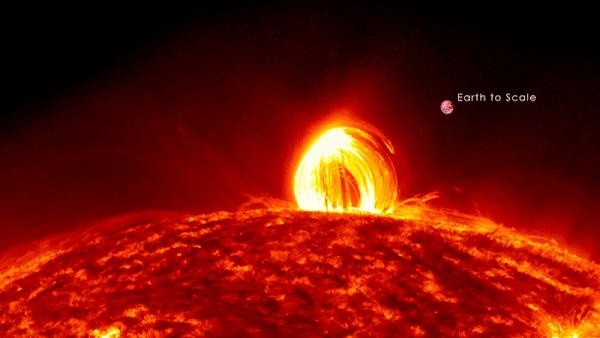NASA satellites discovered a sunspot on our Sun's surface as our host star sprayed plasma on the surface. This could result in a solar flare with a speed of 1.8 million kilometers per hour.
Since sunspots have high magnetic fields, these plasmas are usually hotter.

A sunspot's average temperature reaches 3,500 degrees Celsius, even though the average Sun surface temperature is 5,500 degrees Celsius.
The effects are supposed to be minimal as a G1 tornado, Daily Star said. But they may include power grid disturbances and interference with satellite operations.
Although this solar storm is minor, some scientists have cautioned that a massive solar storm is just a matter of "when not if." This is because the Sun also produces a solar flare, which sends radiation into space. Any of these solar flares have the potential to strike Earth, but they are mostly harmless to our atmosphere.
Researchers said per Express UK that it comes when a void has formed in the equatorial portion of the Sun's atmosphere and is releasing solar particles directly into Earth at a speed of 500 kilometers per second.
Solar flares, on the other hand, can be so strong that they cripple Earth's infrastructure.
🔥 The flash of a solar flare lights up our @NASASun telescope as jets of super-heated plasma bloom. But when they're triggered, where do flares come from? One "neat" point or many disconnected locations? A new sounding rocket mission aims to find out: https://t.co/nd4PhhjwDz pic.twitter.com/jL7y62tqn9
— NASA (@NASA) September 26, 2019
What Causes Solar Flares?
The Sun has been discovered to have produced plasma sprays on its surface, which is unusual for the Sun's surface to do or exhibit, according to Express UK. This is also known as a "Sunspot," which are darkened regions on the star's surface that is usually colder than the yellow areas of the hot gaseous ball.
These Sunspots are magnetic fields that block heat from developing, keeping a maximum temperature of 3,500 degrees Celsius, relative to the 5,500 degrees Celsius of the system's largest star. Sunspots can also cause "Solar Flares," which are eruptions on the Sun's surface that are thought to be expulsions from the star.
NASA satellites from the Solar Dynamics Observatory observed this phenomenon. As noted by Dr. Tony Phillips' Space Weather Blog, this is an "offing" phenomenon. As mentioned on the blog, Sunspot appeared many days ago, implying that it has been active since the last week of April.
Solar Eruptions: Messy or Neat?
According to the blog, sunspots are active. Dr. Phillips has advised that the movements and progress of the Sun be monitored in the coming days, as they are important for humans as well. Even if the Sunspot is in a distant area of the Sun, it is still worth keeping an eye on with a telescope or a lens with safety.
Currently, this phenomenon with the Sun is nothing to be concerned for or alarmed about, since it is unlikely to affect people's everyday lives on Earth. However, astronomers should be concerned because it could indicate that something is wrong with the Sun and could have a long-term impact that could be dangerous.
NASA said solar storms could last anywhere from a few minutes to several hours. But the effects of geomagnetic storms can last for days to weeks in the Earth's magnetosphere and atmosphere.
Solar flares that strike Earth are usually innocuous. However, the Sun will produce flares that are so strong that they will cripple Earth's infrastructure. For example, NASA said a solar storm knocked out electricity over the entire province of Quebec in Canada in 1859.
RELATED ARTICLE : Earth on Geomagnetic Storm Watch, NASA Says Occurrence Not Terrifying as It Sounds
Check out more news and information on Space on Science Times.










